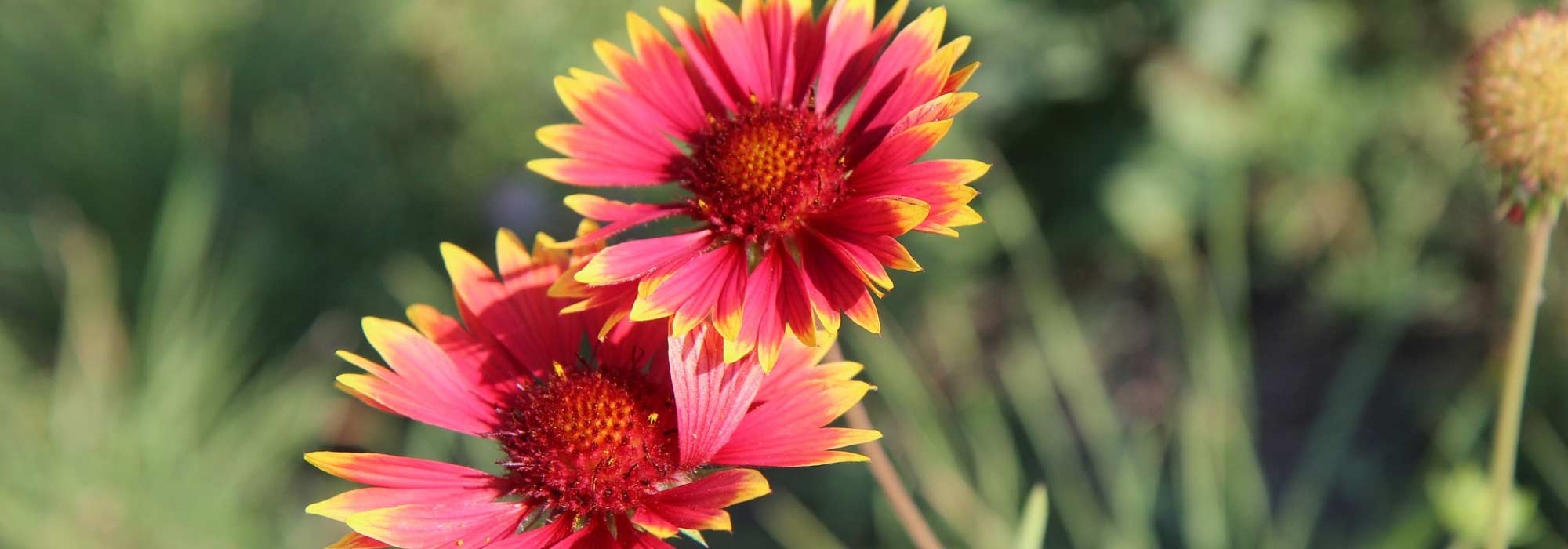
Gaillardia: planting, sowing, maintenance
Contents
Gaillardia in a nutshell
- It’s a champion of floral abundance! It blooms continuously from late spring to early autumn.
- Its daisy flowers, as original as they are vibrant, showcase warm colours and possess the hardy charm that evokes the countryside so well.
- Annual or perennial, it’s a very easy plant to grow, with exemplary undemanding qualities, thriving in the sun even in poor soil.
- Hardy (perennial gaillarde) and drought-resistant, it’s foolproof!
- It will bring a distinctly rural touch to your borders, meadow or gravel gardens, rockeries, pots, or your bouquets in summer or autumn.
A word from our expert
The one we once appreciated in our grandmothers’ gardens is unmatched for colouring the garden with its large simple or double heads resembling brown, russet, orange, or golden yellow daisies.
With its warm and vibrant colours and its centre as big as this, always surrounded by brown or a lighter shade, the Gaillardia is both simple and welcoming.
A bit out of fashion today, with its sturdy and rustic charm that evokes the countryside, the perennial or annual Gaillardia combines hardiness with an exceptionally long flowering period.
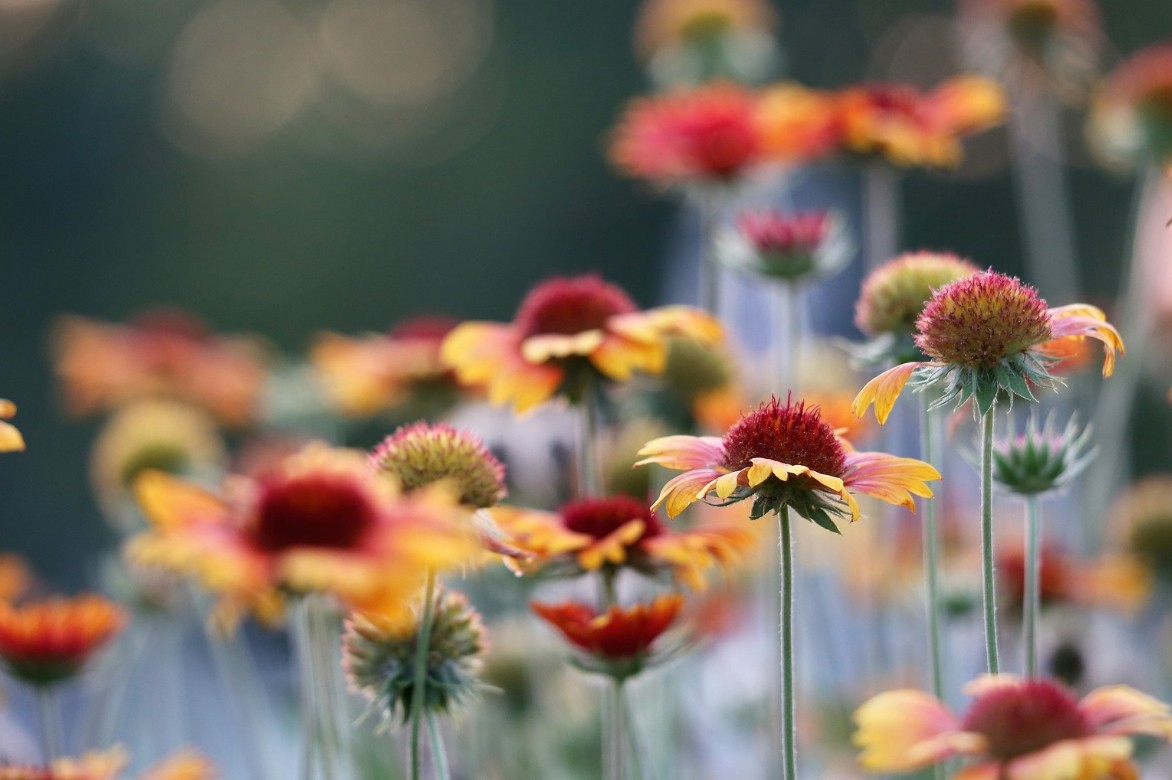
From the Royal Gaillardia to the large-flowered red burgundy Gaillardia (‘Burgunder’), through the awned Gaillardia and the ‘Kobold’ perennial Gaillardia, it is indeed one of the most floriferous and easiest plants to grow.
It is also one of the most beautiful flowers for summer bouquets!
Exemplarily undemanding, drought-resistant, and requiring little maintenance, this plant is truly a boon for poor, well-drained soils.
Its rapid growth and abundant flowering make it essential for brightening up borders, rockeries, scree gardens, as well as pots and window boxes throughout the summer.
Discover our perennial or annual Gaillardias in buckets or seeds to create colourful scenes in the garden or on a sunny terrace; they bloom all summer and are nearly foolproof!
Description and Botany
Botanical data
- Latin name Gaillardia
- Family Asteraceae
- Common name Blanket Flower
- Flowering from May to October
- Height 0.15 to 1 m
- Exposure Sun
- Soil type All, well-drained
- Hardiness frost-sensitive or hardy down to -15°C-20°C depending on varieties
Originating from the vast plains and sunny slopes of North and South America, the Blanket Flower belongs, like sunflower, aster, or daisy, to the large family of Asteraceae.
Among the 30 species of annuals, biennials, and perennials in the genus Gaillardia, the hybrids of Gaillardia grandifolia (Gaillardia x grandiflora), Gaillardia aristata or aristate gaillardia, the wild form (aristata (x) pulchella), and Gaillardia pulchella, an annual species, are mainly found in our gardens. They come in over 30 varieties and cultivars distinguished by their size, colours, and hardiness.
The Blanket Flower is a fast-growing perennial but has a short lifespan. It quickly forms beautiful clumps of leafy, bushy, and branched stems ranging from 0.30 to 80 cm in height depending on the varieties. The habit is more or less upright, compact (G. Aristata) or airy (Gaillardia grandifolia). The perennial gaillardias form dense and highly floriferous clumps in just two years.
From a clump of leaves gathered in a basal rosette, branched stems rise, dotted with leaves 3 to 30 cm long, entire, slightly lobed, or deeply dissected, with edges that are sometimes dentate or spatulate. Narrow and lanceolate in shape, they are grey-green, medium green to dark green, and are slightly villous.

Gaillardia aristata – botanical illustration
With its pubescent texture, this deciduous, evergreen, or semi-evergreen foliage serves as a backdrop to the abundant and radiant flowering.
The Blanket Flower is highly valued for its very long flowering period from late spring to early autumn. From June to October, it endlessly blooms with daisy-like flowers, borne singly at the ends of upright stems. The long stalks bear terminal inflorescences in heads measuring 2 to 15 cm in diameter.
Each head consists of a single, semi-double, or double collar of thread-like ligules edged in brown. They surround a central, often highly contrasting, dome composed of tiny, fluffy florets in dark purple, brown, red, or yellow at the periphery. The colour of the heads’ centre evolves from the periphery towards the centre as the seeds mature.
The shape and colour of the ligules vary according to the cultivars. Very irregularly placed in some, they are impeccably tight in a wide plate in others, and sometimes fringed or curiously tubular like in Gaillardia grandiflora ‘Fanfare’, which has unique petal shapes resembling small tubes ending in trumpets.
These large heads that seem painted (some gaillardias are referred to as “painted” Gaillardia pulchella var. picta), display warm and vibrant colours; orange, blood-red (Burgundy Blanket Flower) or brown, and other flamboyant bicolour or tricolour shades sometimes edged in sunny yellow.
They make magnificent lasting bouquets of cut flowers that hold well in a vase.
This tireless flowering delights pollinating insects, bees, and butterflies, which flock around these melliferous heads. The flowers turn into small dry fruits, blonde achenes with long silky hairs topped with an egret that, when ripe, are a feast for birds.
Even when faded, the flowers of the Blanket Flower retain undeniable ornamental interest.
Depending on the varieties, the Blanket Flower is grown in our country as an annual due to its low hardiness against frost or as a fully hardy perennial (down to -20°C) capable of adapting to most gardens in our regions. Little demanding, the Blanket Flower prefers a light, well-drained, even stony soil and a warm, sunny exposure. While it fears neither drought nor heat, the perennial Blanket Flower, however, dreads winter moisture.

Some varieties of Blanket Flowers: Gaillardia aristata ‘Amber Wheels’, Gaillardia grandiflora ‘Lutin’ (photo P. Standish), Gaillardia grandiflora ‘Burgunder’ (photo Francis Bourgouin), Gaillardia grandiflora ‘Kobold’ (©La Ferme de Sainte Marthe)
With its simple flowers and warm colours, it stands out in all corners of gardens without pretension, in natural gardens, as well as in flower meadows where it creates beautiful colourful scenes.
Annual or perennial, it is used as ground cover, at the edge of a wildflower bed or a Catalan-inspired border, in mixed borders. It is also an essential for pot or window box cultivation.
Read also
Planting annualsMain species and varieties
On trouve principalement des variétés, cultivars et hybrides de Gaillardia grandifolia, de Gaillardia aristata et de Gaillardia pulchera (la gaillarde annuelle).
Elles se distinguent par le port plus ou moins compact, la couleur et la forme de leurs ligules, la taille de leurs fleurs, et leur rusticité : annuals or perennials, ces dernières étant les plus nombreuses.

Gaillardia grandiflora Burgunder
- Flowering time July to November
- Height at maturity 60 cm
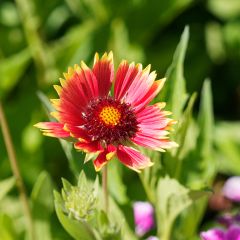
Gaillardia grandiflora Kobold
- Flowering time July to November
- Height at maturity 35 cm
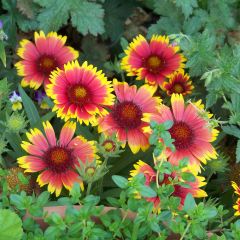
Gaillardia Lutin
- Flowering time July to October
- Height at maturity 30 cm
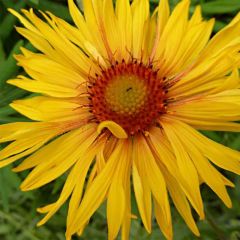
Gaillardia aristata Amber Wheels
- Flowering time July to November
- Height at maturity 75 cm
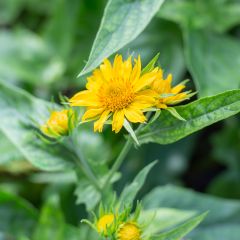
Gaillardia aristata Maxima Aurea
- Flowering time July to November
- Height at maturity 75 cm
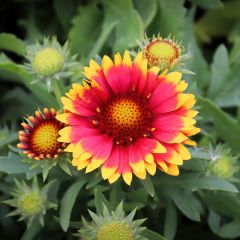
Gaillardia aristata Arizona Sun - Great Blanket Flower
- Flowering time July to October
- Height at maturity 35 cm
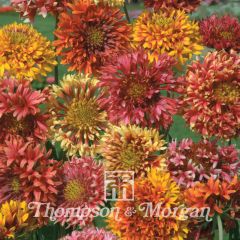
Seeds of annual Gaillardia pulchella Razzle Dazzle
- Flowering time July to October
- Height at maturity 45 cm
Discover other Gaillardia - Blanket Flower
View all →Available in 0 sizes
Available in 1 sizes
Available in 3 sizes
Available in 1 sizes
Available in 2 sizes
Available in 1 sizes
Available in 1 sizes
Available in 1 sizes
Available in 1 sizes
Available in 1 sizes
Planting gaillardes
Where to Plant Gaillardia
With good hardiness (-15°C to -20°C in well-drained soil), Gaillardia perennial grows almost everywhere in France and adapts to all climates. Once well-rooted, it thrives year after year, often self-seeding.
The annual gaillardia (Gaillardia pulchella) is a frost-sensitive plant that disappears below 5°C. This is why, this tender plant will be grown as an annual in the garden, in window boxes or pots to be replaced each year in spring.
All require full sun and a warm location to bloom well. A sheltered spot from strong winds is advisable for the taller varieties, which may need staking.
They appreciate light, well-drained soils, even stony and calcareous ones.
Short-lived but undemanding, it can thrive in poor soil as long as it is well-drained. However, the perennial gaillardia fears waterlogged soils in winter; winter flooding can be fatal.
In pots, a more fertile substrate will enhance its growth and flowering.
The perennial Gaillardia is a boon for gardeners wishing to abundantly flower their beds throughout summer without the need to replant each year; it grows on its own with minimal care.
In the garden, as it self-seeds very abundantly, provide it with enough space to flourish comfortably.
This daisy with warm colours finds its place in all unpretentious gardens, creating colourful scenes. Plant it in flower beds and borders, along pathways, in paving, in a wild meadow, in pots on the terrace or even in the vegetable garden or in a melliferous garden as our grandmothers did.
With their compact habit and limited size, the dwarf varieties also make excellent bright ground cover for dry slopes, in a scree garden or a rockery.
When to Plant Gaillardia
Planting of the perennial Gaillardia is done in spring in March and April in cold regions or in autumn from September to November elsewhere, after the last severe frosts and intense heat. Plant the annual varieties in May when all risk of frost has passed.
How to Plant Gaillardia
In the Ground
To thrive, the Gaillardia prefers well-draining soil: lighten heavy soils with some river sand and gravel.
Count 3 to 7 buckets per m² depending on the varieties, spaced 0.30 to 0.40 m apart: for a beautiful effect, gaillardias can be used in large masses, either alone or mixed with other perennials.
- Soak the root ball in a basin of water for 1 hour before planting
- Prepare the soil well, removing weed roots and stones
- Make a bed of gravel at the bottom of the hole
- Place the root ball in the centre of the hole, with the collar level with the soil
- Cover with soil
- Firm down with your foot
- Water regularly after planting until established
- In spring, protect young shoots from snails and slugs
Planting Gaillardia in Pots
Plant your gaillardia in a large pot or window box in a mix of potting soil for flowering plants and sand or gravel.
- Count 2 to 4 buckets for larger containers
- Water while allowing the substrate to dry out between waterings, do not let water stagnate in the saucers
- Fertilise regularly
 Gaillardia flowers are melliferous
Gaillardia flowers are melliferous
Sow gaillardia seeds
Sowing Gaillardia Under Cover
From March to May, sow Gaillardia seeds, either annual or perennial, in trays under cover at 20°C in a good quality, well-drained seed compost.
- Lightly cover the seeds with a thin layer of compost
- Gently firm down and keep them in the light
- Keep the substrate just moist until germination (10-20 days)
- When they have 3 to 4 leaves, transplant the seedlings into individual buckets
- From May onwards, plant them out in the open ground
→ Learn more in our advice sheet: How to Sow Gaillardia?
Sowing Directly in the Ground
You can also sow directly in place when all risk of frost has passed, in well-prepared, light, and warmed soil from May to June, at a rate of 2 or 3 Gaillardia seeds, either annual or perennial, per cluster every 30 cm. Feel free to mix different varieties together to create warm, colourful displays.
Maintenance, pruning and care
The Gaillardia is truly very easy to grow. Low-maintenance, its care is kept to a minimum.
Robust and hardy, once well-established, the perennial Gaillardia tolerates dry spells well: there’s no need to water after the first year of planting, as the plant can do without watering, except during prolonged summer droughts. It rots in heavy, poorly drained soil that is constantly waterlogged.
In pots, it needs to be watered more regularly during hot weather, especially if it doesn’t rain. It also shows a greater appetite: feed it with a liquid fertiliser every two weeks during the growth period.
Regularly remove faded flowers to encourage a second flowering in September.
A cutback, especially in the first year, is recommended to allow the clump to thicken. At the end of September or early October, clean up the dead foliage and cut back the clump to 10 cm above the soil to promote branching, especially if it shows signs of weakness.
To strengthen and especially regenerate your Gaillardia plants, divide the clumps in spring or autumn, after two to three years of growth.
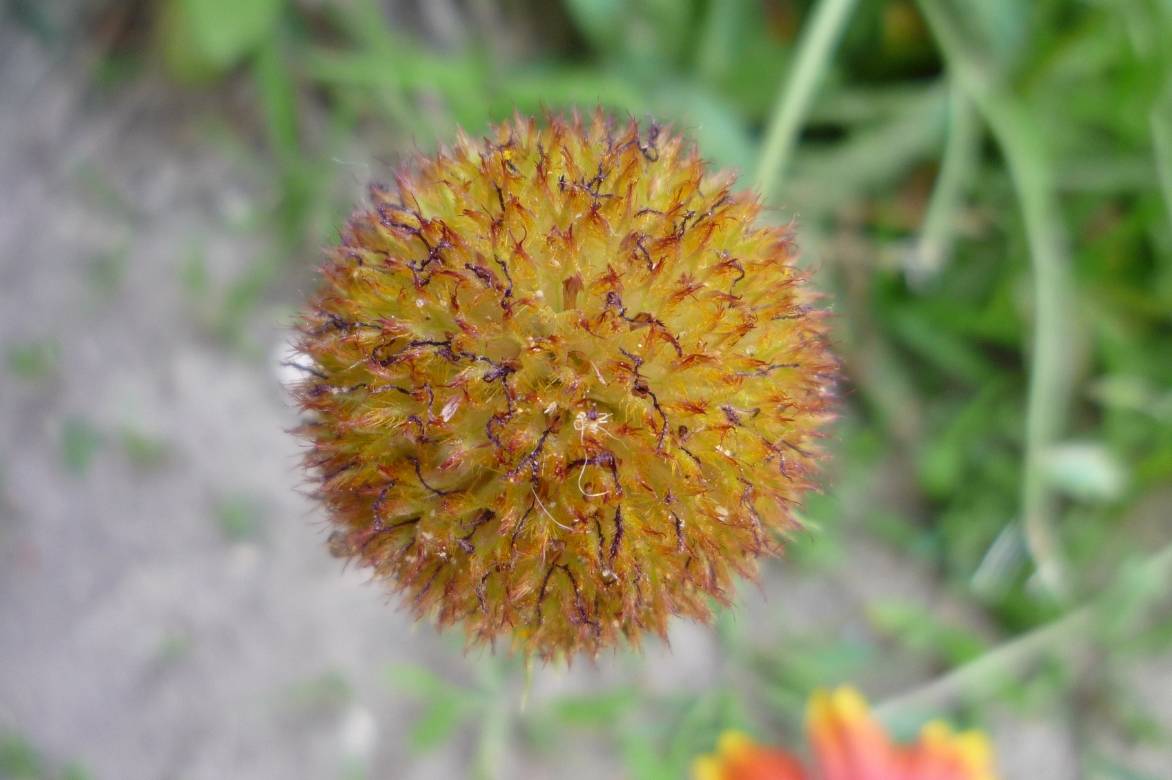
Wilted gaillardia flower
Diseases and potential pests
As its name suggests, the Gaillardia is a sturdy and robust plant, generally not prone to disease.
However, it is wise to protect it in spring from the appetite of slugs that devour the young shoots: use fern manure to combat their attacks. Discover our 7 ways to effectively and naturally combat slugs and how to make a slug trap.
It is primarily vulnerable in poorly drained soil. In case of excess moisture, it can be sensitive to powdery mildew in spring or late summer, characterised by a white fluff on the foliage. As a preventive measure: water at the base without wetting the leaves, spray with horsetail decoctions or nettle manure, or even Bordeaux mixture. In case of infection: promptly remove the affected parts or plants and burn them.
The Gaillardia can also fall victim to grey rot (botrytis) in winter if your soil is too moist. In case of an attack, uproot the affected clumps.
Multiplication: division of Gaillardia clumps
If sowing is possible with seeds harvested in autumn, we recommend multiplying Gaillardia by clump division in spring. Carry out the division of Gaillardia on mature clumps that are at least 3 years old.
To do this:
- gently lift the clump with a fork,
- using a sharp spade, separate a few clumps with a maximum of roots,
- immediately replant these root clumps in the garden in well-prepared soil.
Associate
The Gaillardia, whether annual or perennial, is essential in a natural garden, in mixed borders and in unpretentious country-style flower beds where it brings a charming, childlike appeal.
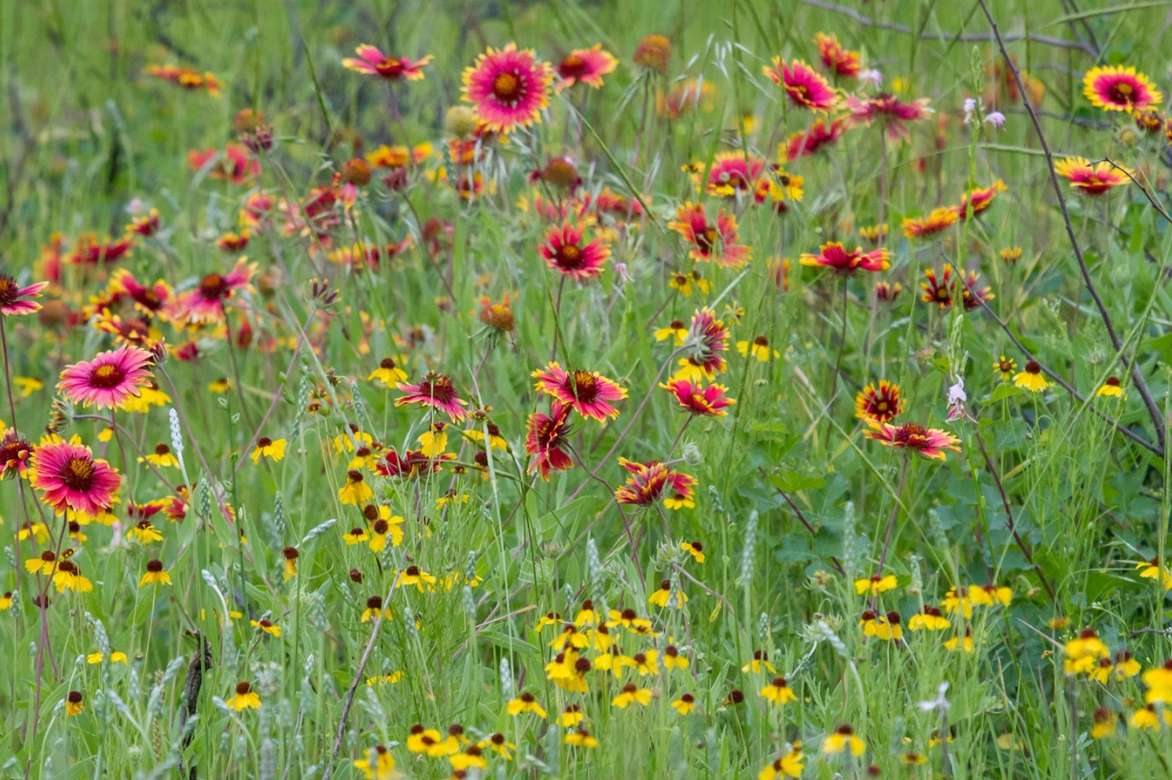
An example of natural pairing: Gaillardia pulchella, Rudbeckia with small flowers like R. triloba (photo Larry Smith-Flickr)
It brightens up all areas of the garden with its very colourful silhouette in warm, vibrant shades of red and yellow, which blend perfectly with various plants, both perennials and annuals, that, like it, enjoy full sun.
With its rustic charm that evokes the countryside, the Gaillardia combines robustness with floribundity. It is also one of the most beautiful cut flowers!
Its sunny flowers, simple daisies, bring liveliness and character, sometimes even reaching a tasteful eccentricity, to all summer scenes. It can also provide contrast in multicoloured arrangements.
To flower a sunny spot with minimal effort, one can create a clever mix of self-sowing plants; a few feet of echinaceas paired with sedums, asters, chrysanthemums, bidens, Oriental poppies, lupins, and daisies.
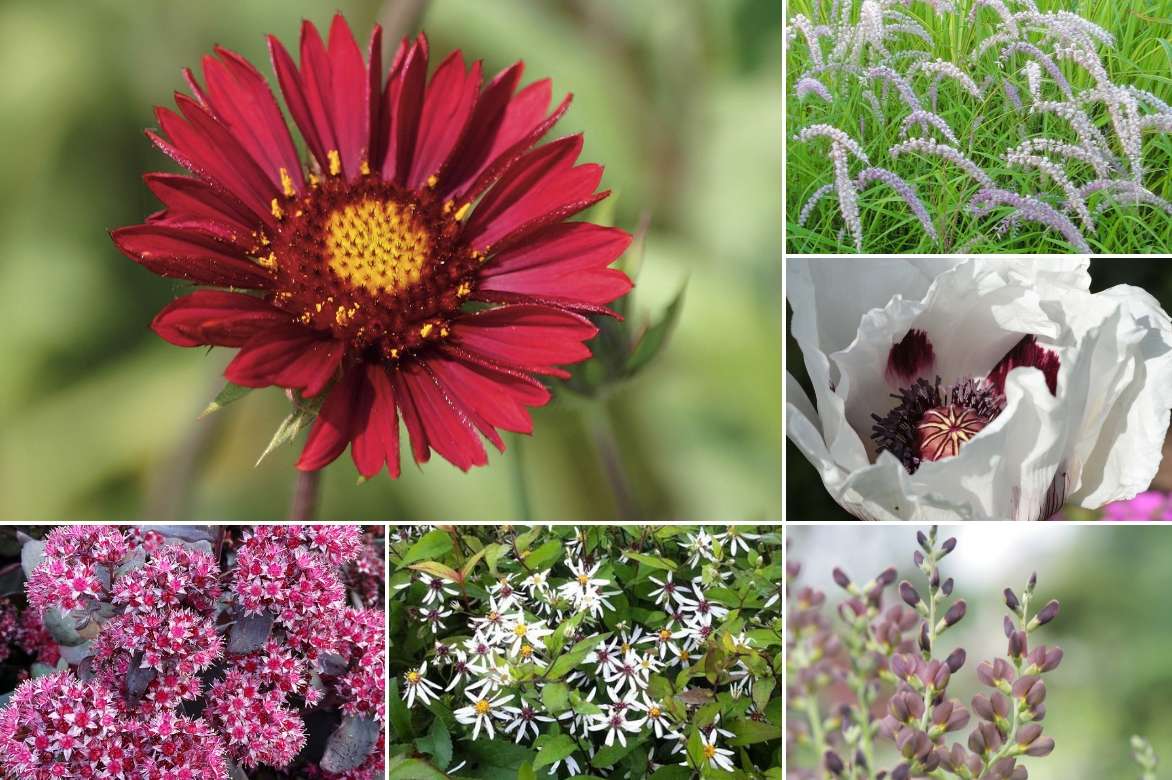
An idea for pairing flowers for months: Gaillardia ‘Burgunder’ (photo Francis Bourgouin), Pennisetum orientale, Papaver orientale ‘Perry’s White’, Baptisia australis ‘Dutch Chocolate’, Aster divaricatus, and Sedum ‘José Aubergine’
Rely on the warmth and vibrancy of Gaillardia colours to add character to a cheerful summer border or to dress the base of a hedge composed simply of small cosmos, osteospermum, annual rudbeckias, and daylilies.
The often compact silhouette and the well-defined shape of Gaillardia flowers introduce vigorous accents into a flower bed. Airy grasses like Stipas, tufted cocksfoot, and Pennisetums will be the perfect companions to balance its somewhat stiff habit, bringing softness, movement, and above all, a lovely lightness to a naturalistic scene. The flowers of Gaillardia will contribute to the brilliance while the grasses will temper the fire.
Create a flower bed of Catalan inspiration in vibrant tones, with a few feet of large cannas, copper heleniums, echinaceas in spicy colours, tritomas, or even achilleas with coral-red flowers to accompany your gaillardias until the first frosts.
In a dry, sunny rockery, it will accompany lavenders, santolines, cistus, and hardy geraniums which are equally undemanding and floriferous.
In a flowering meadow, pair it with Leucanthemum, scabious, and St. John’s anthemis.
For a bee-friendly border in a vegetable garden, invite dahlias and nasturtiums to join it.
→ Discover more pairing ideas with Gaillardias in our advice sheet.
Useful resources
- With their copper orange, blood red, or sienna earth colours, Gaillardes are perfect for complementing a Catalan-inspired border!
- Which annual plants should you pair with your gaillardes?
- Gaillardes: 5 ideas for pairing them
- Subscribe!
- Contents
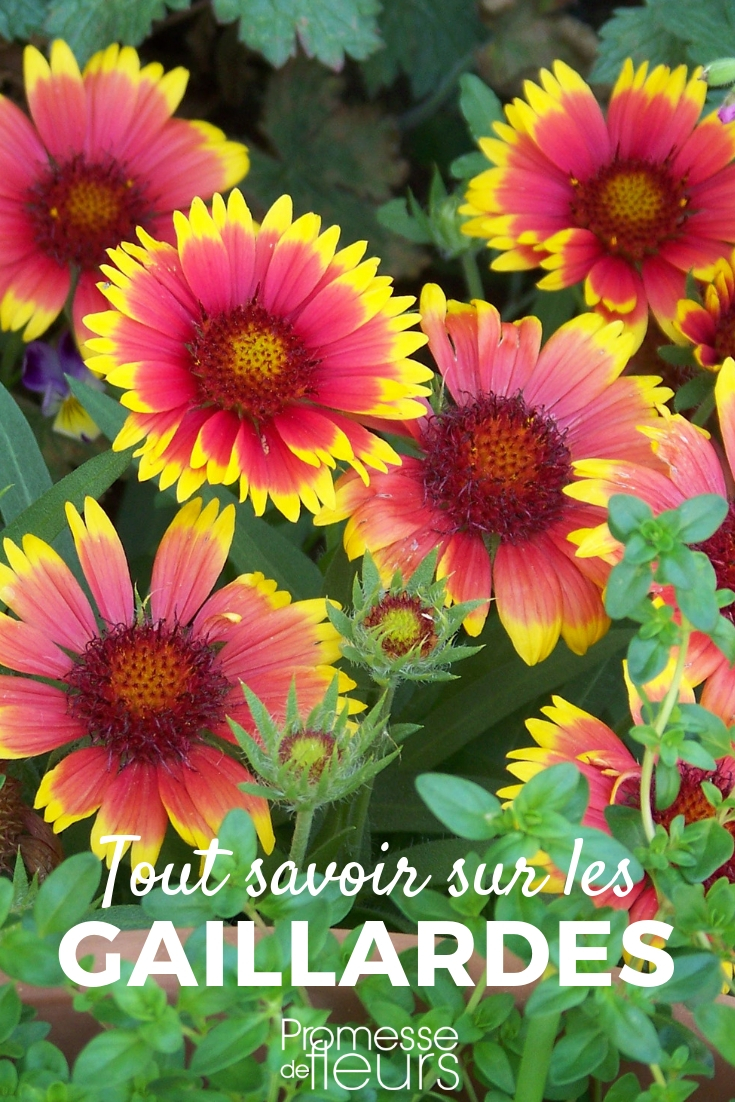































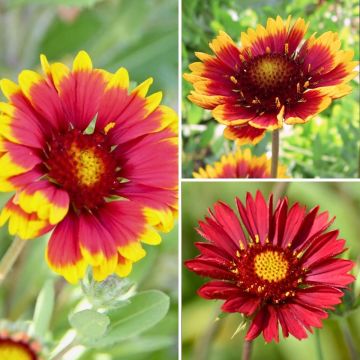


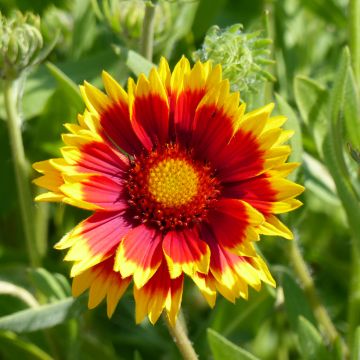
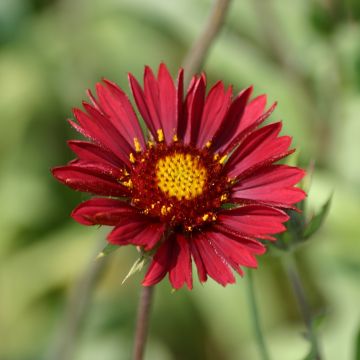
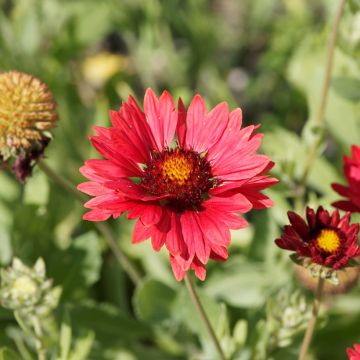
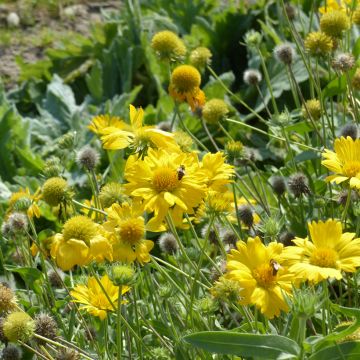


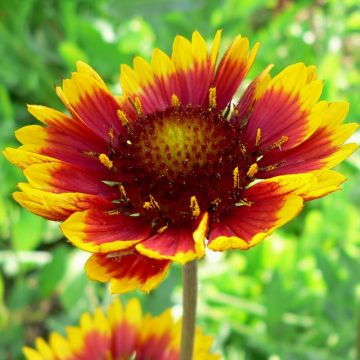
Comments